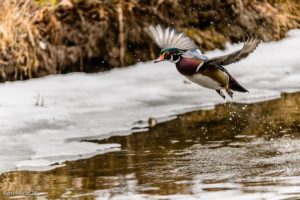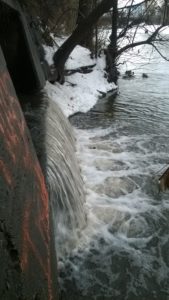 The Boise River will have better habitat for fish and wildlife and cleaner water and more community members, including refugees, will participate in stewardship activities if funding is awarded to two BREN-facilitated collaborative enhancement projects.
The Boise River will have better habitat for fish and wildlife and cleaner water and more community members, including refugees, will participate in stewardship activities if funding is awarded to two BREN-facilitated collaborative enhancement projects.
Cottonwood Creek Daylighting Project
BREN partnered with the Ted Trueblood Chapter of Trout Unlimited, City of Boise, Idaho Department of Fish and Game, Boise Valley Fly Fishers, Ada County Highway District, Intermountain Bird Observatory, and Land Trust of the Treasure Valley to apply for Phase II funding from the U.S. Bureau of Reclamation Cooperative Watershed Management Program for the Cottonwood Creek Daylighting Project. The creek now flows through a buried flume underneath Julia Davis Park before discharging to the river.

The Boise River Enhancement Plan identifies channel confinement and simplification as the #1 issue impairing geomorphology and fisheries habitat in the Boise River and recommends daylighting tributaries to improve habitat complexity. This exciting project would create an open stream channel through the park and improve the confluence with the river to allow for fish passage. The daylighted creek will support salmonid spawning and rearing habitat and create new wetland and riparian habitat that supports wildlife and improves water quality.
The project includes a robust engagement, education and outreach component with many opportunities for volunteers to participate. Knowledge transfer and inspiration will support similar collaborative efforts throughout the watershed. Awards will be announced in May.
Hyatt Hidden Lakes Multicultural Habitat Project

BREN teamed up with many partners to apply for funding from the National Fish and Wildlife Federation for the Hyatt Hidden Lakes Multicultural Habitat Project. The project will engage refugees from many nations and traditional conservation stewards in transforming weed-dominated uplands at the City of Boise’s Hyatt Hidden Lakes Reserve into healthy habitat for passerine birds and non-game animals. The Boise River Enhancement Plan identifies invasive plants as a primary issue affecting habitat function and value, and the removal of invasive plants and planting of native vegetation is a top recommendation.
Under the leadership of BREN and the Land Trust of the Treasure Valley, the collaborative project will engage existing and new volunteers, including refugees who live nearby, to remove weeds and plant native trees, shrubs and grasses on 12 acres. Volunteers will collect local seeds and grow some of the plants for the project, greatly increasing plant survival. Partners will provide on-and-off site educational programs and host field trips and work days. BREN will share stories and photos of the project to increase support for Boise River enhancement.
Partners are City of Boise, Land Trust of the Treasure Valley, Golden Eagle Audubon Society, Idaho Weed Awareness Campaign, Partners for Clean Water, The Wetlands Group, Boise State University, Idaho Office of Refugees, Idaho Department of Fish and Game, and Big Brothers Big Sisters. Awards will be announced in July.
BREN Helps Local Stakeholders Collaborate
In 2011, lower Boise River stakeholders agreed that increased cooperation, communication and networking was needed to advance ecological enhancement of the river. The Boise River Enhancement Network was founded to provide those essential connecting services; to serve stakeholders as a “backbone” organization whose staff or volunteers plan, manage, and support enhancement work. BREN facilitated development of the Boise River Enhancement Plan in 2014/2015, maintains a website, Facebook page and email list to support communication, hosts numerous educational events each year, engages members and volunteers in reviewing, designing and implementing enhancement projects and assembles collaborative teams to pursue funding for projects like these that align with the Enhancement Plan. Please let us know how BREN can support your enhancement project.